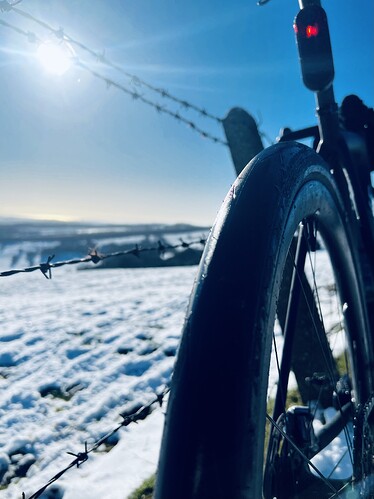It was specifically riding over a rough cobbled surface, not a smooth road.
When I say feels sluggish, I also mean I’m down by 1-2km/hr speed wise. Over enough rides for this to be a consistent theme regardless of weather conditions, road conditions, power output etc. Which is a bigger difference than I’d expect, between any of my full slick tyres.
Ahhh…Bicycle Rolling Resistance has them down as 15.6w for 35mm, Vs 10.4w for Schwalbe Pro One… Maybe the data does stack up a little…
What pressures are you comparing, the same pressures or equivalent pressures (= the ones you would actually inflate your tires to)?
The idea that wider tires makes you faster over certain surfaces is based upon the amount of energy you lose from vibration losses. Zipp has data on their website to go along with the release of their XPLORER wheels. Wider internal width, wider external width for use with wider tires means less energy loss from vibration. 303 XPLR Tech Deep Dive | SRAM
Aero loss from running wider tires then the wheels is still a thing, but running wider tires on super wide wheels at lower pressures negates the aero efficiency losses and reduces the energy losses from vibration.
It negates some of the aero efficiency loss. Narrow tyre & narrow rim > wide tyre & wide rim > wide tyre & narrow rim in aeroness. Rolling efficiency will improve with the wide tyre and rim combo on rough ground, so if the ground is rough enough and/or you are travelling slow enough then the wide tyre and rim combo will be overall faster taking into account aero and rolling resistance. If your roads are smooth, then the narrow tyre is faster.
Here is an old GCN video showing the difference in tire pressure and how it affects your speed for a given power. https://youtu.be/uBMNGpPPHVw?si=opytDZ2Fz2-zgE97
35mm probably in the 50-60psi range. 25mm in the 80psi range. So what I would say are the intended riding pressures for my weight.
No, I meant the friction loss data in the rolling resistance tests, did you compare equivalent pressures?
I see that now. Their tables rendered funny in my browser. I think if I’m reading this right then, they’re still reporting a 16w savings at 40kph with 40c vs 26c then?
If so, I’m still skeptical based on my personal data with those 38c vs 28c tires. I’ve got the 38c being ~25w slower at ~40kph when looking through similar efforts on the same road stretch.
Ahhh, well that’s difficult, as BRR website for non-subscribers provides only rolling resistance at 100/110 psi for the 25mm tyre and 30/40psi for the 35mm tyres.
35mm would likely feel terribly harsh at anywhere near 100psi. And assuming that was even within the max pressure for that width, I don’t know.
Me, coming into the thread excited to have my hands on some 35C GP5000 AS

Oh ![]()
Well as long as they feel faster than the 35c coming off, I’ll take it.
I have enjoyed 38mm Schwalbe Pro Ones this winter on my Crux. Fat slicks are great and these are faster than GP5000AS 35mm on BRR.
It’s between Caracal Race 40 and 2.1 Burts for the summer depending on where I ride.
I’m running 25/28 combo at 50 psi. I’m just not sure I’m going to benefit from 40mm.
Don‘t we need to talk about which tire width looks the fastest too?
Joking aside, I‘m feel like when I pump up my 42mm tires to a pressure a bit higher than usual, they are quite fast. I didn‘t have my road bike for some time and did this a lot. But the tires also feel harder with high pressure and are worse on gravel. It probably negates some of the pros of bigger tires. Maybe they are still cushier because of bigger air volume and hence faster?
I‘m sure I can go fast with MTB tires too, just go high in pressure. But they aren‘t usuable on mud like this.
With lower (recommend) pressures bigger is slower. Not by much, maybe ~30watts at 35kmh comparing Specialized Pathfinder Pro 42mm to GP5000S TR 30mm (the former a race, the latter an endurance bike).
Not sure this is correct. Excluding gravel or cobble stages my understanding is at the Tour nearly every team runs 26-30mm, and the teams on 30mm are those using wide hookless wheels like Zipp or Enve where they may have to for compatibility reasons.
I also think the idea that the pros are conservative with their equipment is out of date. There are very data driven guys like Josh Poertner, Dan Bigham, Jean-Paul from Swissside advising the teams, if there was data supporting going wider on decent roads we’d be seeing the pros go wider.
Something like Paris Roubaix is obviously a totally different story, and is why most of the frames will now accommodate 32mm or even wider.
Glad the word is getting out about the advantages of wider tires & lower pressures. The test data was readily available some years ago.
29” x 2.5” @ 22psi.
Perfecto!
I’m running 16 front and 18 rear in that size.
I’m running 16 and 18 at times on 2.4!
Sorry if this is old news but I read all this article and looked at the graphs.
Per CN:
The net (CRR and CdA) energy cost of the tires got larger as the tires got larger on pavement. Negligible benefit of going bigger that’s outweighed by the aero losses.
The opposite occurred on cobbles. The larger ones were faster. Not surprised. This trend likely would continue to a 2.2 or 2.4… similar to Dylan J’s tests on same rig.
If there are two distinct areas it’s worth following the tires pros are running its world tour road racing and World Cup xco mtb. 700 x 28-30 for the former and 29 x 2.4 for the latter. Bigger road tires for spring classics.
There is also a pavement roughness continuum to look at but that might require some more work.
Anyway. Dunno bout that headline.
Gotta go test some Corsa Controls in a 34
Thanks - I’ll try going lower
